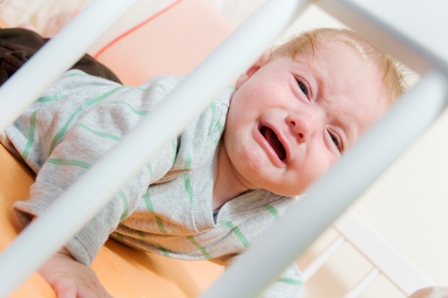User login
Behavioral sleep interventions can work – if done
Sleep has begun to emerge from the shadows to gain its rightful place in the health pantheon. With this emergence has come a motley group of physicians and self-proclaimed experts (myself included) eager to share their anecdotal evidence and opinions on how new parents can shorten the inevitable and often painfully slow process of settling in.
A study in the May 2018 Journal of Pediatrics is an attempt to provide some data-driven guidance for sleep-deprived parents and their physician-advisors (“Real-World Implementation of Infant Behavioral Sleep Interventions: Results of a Parental Survey”). Using the responses from 652 parents who participated in a Facebook peer support group, the investigators created four categories of behavior sleep intervention for the parents of infants a mean age of 6 months: Modified extinction in which parents left the room and returned to briefly reassure the infant at intervals ranging from 5 to 25 minutes; unmodified extinction in which the parents let the infant cry it out; parental presence with support in which the parents remained in the room and interacted with the child; and parental presence without support. Extinction, both modified and unmodified (50% and 35%), was far and away the most frequently used method.
There was little difference in the effectiveness of the four strategies. By 2 weeks, 79% of the parents reported success, and the interventions were successfully discontinued in a mean and mode of 7 days. Not surprisingly, with success came reduced parental stress, as well as more consistent bedtime routines and smoother transitions to sleep.
When choosing a behavioral sleep intervention to suggest, I have tried to consider what I have learned about each family’s personality in the few months I have gotten to know them. But I have always been a big fan of extinction. And I suspect that my bias is simply a reflection of my no-nonsense, let’s-get-it-done-now personality. The results of this new study suggests that my poorly disguised pessimism about parental presence strategies may have discouraged some parents from trying an intervention that might have been successful for them.
The good news is that all four strategies can be successful. The problem is helping parents find the time and energy required to make any intervention successful. In the short term, extinction or parental presence is likely to mean less sleep for the parents. If work schedules and other family stressors already have drained a family’s energy reserves, it may not be the right time to try an intervention. When it becomes clear that there is never going to be right time, it is time for a frank discussion with the family about rearranging their priorities.
Behavioral sleep interventions require consistency and a family must be prepared to commit at least a week of uninterrupted evenings to get the job done. Business trips, visitors, and social engagements must take a back seat.
Extinction strategies are going to involve some crying, and while as pediatricians, we have developed the ability to buffer ourselves from crying (ignore really isn’t the right word), we must accept that listening to one’s child is too painful for some parents. When only one parent can’t tolerate the crying, the solution may be having that parent leave the home on the intervention evenings. When both parents share the vulnerability, the better answer is a parental presence strategy.
Although this study was small with a self-selected group of parents, the good news is that behavioral sleep intervention can work. We need to share the news with young families and encourage them to just do it.
Dr. Wilkoff practiced primary care pediatrics in Brunswick, Maine, for nearly 40 years. He has authored several books on behavioral pediatrics, including “Is My Child Overtired?: The Sleep Solution for Raising Happier, Healthier Children.” Email him at [email protected].
Sleep has begun to emerge from the shadows to gain its rightful place in the health pantheon. With this emergence has come a motley group of physicians and self-proclaimed experts (myself included) eager to share their anecdotal evidence and opinions on how new parents can shorten the inevitable and often painfully slow process of settling in.
A study in the May 2018 Journal of Pediatrics is an attempt to provide some data-driven guidance for sleep-deprived parents and their physician-advisors (“Real-World Implementation of Infant Behavioral Sleep Interventions: Results of a Parental Survey”). Using the responses from 652 parents who participated in a Facebook peer support group, the investigators created four categories of behavior sleep intervention for the parents of infants a mean age of 6 months: Modified extinction in which parents left the room and returned to briefly reassure the infant at intervals ranging from 5 to 25 minutes; unmodified extinction in which the parents let the infant cry it out; parental presence with support in which the parents remained in the room and interacted with the child; and parental presence without support. Extinction, both modified and unmodified (50% and 35%), was far and away the most frequently used method.
There was little difference in the effectiveness of the four strategies. By 2 weeks, 79% of the parents reported success, and the interventions were successfully discontinued in a mean and mode of 7 days. Not surprisingly, with success came reduced parental stress, as well as more consistent bedtime routines and smoother transitions to sleep.
When choosing a behavioral sleep intervention to suggest, I have tried to consider what I have learned about each family’s personality in the few months I have gotten to know them. But I have always been a big fan of extinction. And I suspect that my bias is simply a reflection of my no-nonsense, let’s-get-it-done-now personality. The results of this new study suggests that my poorly disguised pessimism about parental presence strategies may have discouraged some parents from trying an intervention that might have been successful for them.
The good news is that all four strategies can be successful. The problem is helping parents find the time and energy required to make any intervention successful. In the short term, extinction or parental presence is likely to mean less sleep for the parents. If work schedules and other family stressors already have drained a family’s energy reserves, it may not be the right time to try an intervention. When it becomes clear that there is never going to be right time, it is time for a frank discussion with the family about rearranging their priorities.
Behavioral sleep interventions require consistency and a family must be prepared to commit at least a week of uninterrupted evenings to get the job done. Business trips, visitors, and social engagements must take a back seat.
Extinction strategies are going to involve some crying, and while as pediatricians, we have developed the ability to buffer ourselves from crying (ignore really isn’t the right word), we must accept that listening to one’s child is too painful for some parents. When only one parent can’t tolerate the crying, the solution may be having that parent leave the home on the intervention evenings. When both parents share the vulnerability, the better answer is a parental presence strategy.
Although this study was small with a self-selected group of parents, the good news is that behavioral sleep intervention can work. We need to share the news with young families and encourage them to just do it.
Dr. Wilkoff practiced primary care pediatrics in Brunswick, Maine, for nearly 40 years. He has authored several books on behavioral pediatrics, including “Is My Child Overtired?: The Sleep Solution for Raising Happier, Healthier Children.” Email him at [email protected].
Sleep has begun to emerge from the shadows to gain its rightful place in the health pantheon. With this emergence has come a motley group of physicians and self-proclaimed experts (myself included) eager to share their anecdotal evidence and opinions on how new parents can shorten the inevitable and often painfully slow process of settling in.
A study in the May 2018 Journal of Pediatrics is an attempt to provide some data-driven guidance for sleep-deprived parents and their physician-advisors (“Real-World Implementation of Infant Behavioral Sleep Interventions: Results of a Parental Survey”). Using the responses from 652 parents who participated in a Facebook peer support group, the investigators created four categories of behavior sleep intervention for the parents of infants a mean age of 6 months: Modified extinction in which parents left the room and returned to briefly reassure the infant at intervals ranging from 5 to 25 minutes; unmodified extinction in which the parents let the infant cry it out; parental presence with support in which the parents remained in the room and interacted with the child; and parental presence without support. Extinction, both modified and unmodified (50% and 35%), was far and away the most frequently used method.
There was little difference in the effectiveness of the four strategies. By 2 weeks, 79% of the parents reported success, and the interventions were successfully discontinued in a mean and mode of 7 days. Not surprisingly, with success came reduced parental stress, as well as more consistent bedtime routines and smoother transitions to sleep.
When choosing a behavioral sleep intervention to suggest, I have tried to consider what I have learned about each family’s personality in the few months I have gotten to know them. But I have always been a big fan of extinction. And I suspect that my bias is simply a reflection of my no-nonsense, let’s-get-it-done-now personality. The results of this new study suggests that my poorly disguised pessimism about parental presence strategies may have discouraged some parents from trying an intervention that might have been successful for them.
The good news is that all four strategies can be successful. The problem is helping parents find the time and energy required to make any intervention successful. In the short term, extinction or parental presence is likely to mean less sleep for the parents. If work schedules and other family stressors already have drained a family’s energy reserves, it may not be the right time to try an intervention. When it becomes clear that there is never going to be right time, it is time for a frank discussion with the family about rearranging their priorities.
Behavioral sleep interventions require consistency and a family must be prepared to commit at least a week of uninterrupted evenings to get the job done. Business trips, visitors, and social engagements must take a back seat.
Extinction strategies are going to involve some crying, and while as pediatricians, we have developed the ability to buffer ourselves from crying (ignore really isn’t the right word), we must accept that listening to one’s child is too painful for some parents. When only one parent can’t tolerate the crying, the solution may be having that parent leave the home on the intervention evenings. When both parents share the vulnerability, the better answer is a parental presence strategy.
Although this study was small with a self-selected group of parents, the good news is that behavioral sleep intervention can work. We need to share the news with young families and encourage them to just do it.
Dr. Wilkoff practiced primary care pediatrics in Brunswick, Maine, for nearly 40 years. He has authored several books on behavioral pediatrics, including “Is My Child Overtired?: The Sleep Solution for Raising Happier, Healthier Children.” Email him at [email protected].
Maternal lifestyle affects child obesity
A study published in the British Medical Journal found that women who practiced five healthy habits had children who when they reached adolescence were 75% less likely to be overweight, compared with women who practiced none of the those healthy habits.
The healthy habits were maintaining a healthy weight, eating a nutritious diet, exercising regularly, not smoking, and consuming no more than a moderate amount of alcohol (BMJ 2018;362:k2486). I suspect you aren’t surprised by the core finding of this study of 16,945 female nurses and their 24,289 children. You’ve seen it scores of times. Mothers who lead unhealthy lifestyles seem to have children who are more likely to be obese. Now you have some numbers to support your decades of anecdotal observations. But the question is, what are we supposed to do with this new data? When and with whom should we share this unfortunate truth?
Evidence from previous studies makes it clear that by the time a child enters grade school the die is cast. Baby fat is neither cute nor temporary. This means that our target audience must be mothers-to-be and women whose children are infants and toddlers. On the other hand, telling the mother of an overweight teenager that her own unhealthy habits have probably contributed to her child’s weight problem is cruel and a waste of time. The mother already may have suspected her culpability. She also may feel that it is too late to do anything about it. While there have been some studies looking for an association between paternal body mass index and offspring BMI, I was unable to find any addressing paternal lifestyle and adolescent obesity.
This new study doesn’t address the unusual situation in which a mother of a teenager sheds all five of her unhealthy habits. I guess there may be examples in which a mother’s positive lifestyle change has helped reverse her adolescent child’s path to obesity. But I suspect these cases are rare.
So on one hand but on the other we must be careful to avoid playing the blame game and giving other mothers a one-way ticket on the guilt train. This is just one more example of the tightrope that we have been walking for generations. Every day in our offices we see children whose health is endangered by their parents’ behaviors and lifestyles. In cases in which the parental behavior is creating a serious short-term risk, such as failing to use an appropriate motor vehicle safety restraint system, we have no qualms about speaking out. We aren’t afraid to do a little shaming in hopes of sparing a family a serious guilt trip. When the threat to the child is more abstract and less dramatic – such as vaccine refusal – shaming and education don’t seem to be effective in changing parental behavior.
Obesity presents its own collection of complexities. It is like a car wreck seen in slow motion as the plots on the growth chart accumulate pound by pound. Unfortunately, parents often are among the last to notice or accept the reality. This new study doesn’t tell us whether we can make a difference. But it does suggest that when we first see the warning signs on the growth chart that we should engage the parents in a discussion of their lifestyle and its possible association with the child’s weight gain. The challenge, of course, is how one can cast the discussion without sounding judgmental.
Dr. Wilkoff practiced primary care pediatrics in Brunswick, Maine for nearly 40 years. He has authored several books on behavioral pediatrics, including “How to Say No to Your Toddler.” Email him at [email protected].
A study published in the British Medical Journal found that women who practiced five healthy habits had children who when they reached adolescence were 75% less likely to be overweight, compared with women who practiced none of the those healthy habits.
The healthy habits were maintaining a healthy weight, eating a nutritious diet, exercising regularly, not smoking, and consuming no more than a moderate amount of alcohol (BMJ 2018;362:k2486). I suspect you aren’t surprised by the core finding of this study of 16,945 female nurses and their 24,289 children. You’ve seen it scores of times. Mothers who lead unhealthy lifestyles seem to have children who are more likely to be obese. Now you have some numbers to support your decades of anecdotal observations. But the question is, what are we supposed to do with this new data? When and with whom should we share this unfortunate truth?
Evidence from previous studies makes it clear that by the time a child enters grade school the die is cast. Baby fat is neither cute nor temporary. This means that our target audience must be mothers-to-be and women whose children are infants and toddlers. On the other hand, telling the mother of an overweight teenager that her own unhealthy habits have probably contributed to her child’s weight problem is cruel and a waste of time. The mother already may have suspected her culpability. She also may feel that it is too late to do anything about it. While there have been some studies looking for an association between paternal body mass index and offspring BMI, I was unable to find any addressing paternal lifestyle and adolescent obesity.
This new study doesn’t address the unusual situation in which a mother of a teenager sheds all five of her unhealthy habits. I guess there may be examples in which a mother’s positive lifestyle change has helped reverse her adolescent child’s path to obesity. But I suspect these cases are rare.
So on one hand but on the other we must be careful to avoid playing the blame game and giving other mothers a one-way ticket on the guilt train. This is just one more example of the tightrope that we have been walking for generations. Every day in our offices we see children whose health is endangered by their parents’ behaviors and lifestyles. In cases in which the parental behavior is creating a serious short-term risk, such as failing to use an appropriate motor vehicle safety restraint system, we have no qualms about speaking out. We aren’t afraid to do a little shaming in hopes of sparing a family a serious guilt trip. When the threat to the child is more abstract and less dramatic – such as vaccine refusal – shaming and education don’t seem to be effective in changing parental behavior.
Obesity presents its own collection of complexities. It is like a car wreck seen in slow motion as the plots on the growth chart accumulate pound by pound. Unfortunately, parents often are among the last to notice or accept the reality. This new study doesn’t tell us whether we can make a difference. But it does suggest that when we first see the warning signs on the growth chart that we should engage the parents in a discussion of their lifestyle and its possible association with the child’s weight gain. The challenge, of course, is how one can cast the discussion without sounding judgmental.
Dr. Wilkoff practiced primary care pediatrics in Brunswick, Maine for nearly 40 years. He has authored several books on behavioral pediatrics, including “How to Say No to Your Toddler.” Email him at [email protected].
A study published in the British Medical Journal found that women who practiced five healthy habits had children who when they reached adolescence were 75% less likely to be overweight, compared with women who practiced none of the those healthy habits.
The healthy habits were maintaining a healthy weight, eating a nutritious diet, exercising regularly, not smoking, and consuming no more than a moderate amount of alcohol (BMJ 2018;362:k2486). I suspect you aren’t surprised by the core finding of this study of 16,945 female nurses and their 24,289 children. You’ve seen it scores of times. Mothers who lead unhealthy lifestyles seem to have children who are more likely to be obese. Now you have some numbers to support your decades of anecdotal observations. But the question is, what are we supposed to do with this new data? When and with whom should we share this unfortunate truth?
Evidence from previous studies makes it clear that by the time a child enters grade school the die is cast. Baby fat is neither cute nor temporary. This means that our target audience must be mothers-to-be and women whose children are infants and toddlers. On the other hand, telling the mother of an overweight teenager that her own unhealthy habits have probably contributed to her child’s weight problem is cruel and a waste of time. The mother already may have suspected her culpability. She also may feel that it is too late to do anything about it. While there have been some studies looking for an association between paternal body mass index and offspring BMI, I was unable to find any addressing paternal lifestyle and adolescent obesity.
This new study doesn’t address the unusual situation in which a mother of a teenager sheds all five of her unhealthy habits. I guess there may be examples in which a mother’s positive lifestyle change has helped reverse her adolescent child’s path to obesity. But I suspect these cases are rare.
So on one hand but on the other we must be careful to avoid playing the blame game and giving other mothers a one-way ticket on the guilt train. This is just one more example of the tightrope that we have been walking for generations. Every day in our offices we see children whose health is endangered by their parents’ behaviors and lifestyles. In cases in which the parental behavior is creating a serious short-term risk, such as failing to use an appropriate motor vehicle safety restraint system, we have no qualms about speaking out. We aren’t afraid to do a little shaming in hopes of sparing a family a serious guilt trip. When the threat to the child is more abstract and less dramatic – such as vaccine refusal – shaming and education don’t seem to be effective in changing parental behavior.
Obesity presents its own collection of complexities. It is like a car wreck seen in slow motion as the plots on the growth chart accumulate pound by pound. Unfortunately, parents often are among the last to notice or accept the reality. This new study doesn’t tell us whether we can make a difference. But it does suggest that when we first see the warning signs on the growth chart that we should engage the parents in a discussion of their lifestyle and its possible association with the child’s weight gain. The challenge, of course, is how one can cast the discussion without sounding judgmental.
Dr. Wilkoff practiced primary care pediatrics in Brunswick, Maine for nearly 40 years. He has authored several books on behavioral pediatrics, including “How to Say No to Your Toddler.” Email him at [email protected].
Looking at study results with a critical eye
As a physician you are the embodiment of delayed gratification. You spent more than 20 years in school before you earned a degree that then allowed you spend another 3-plus years in training before anyone would consider you a “real” doctor. Somewhere along that long and shallow trajectory someone may have said, “You must have done really well on the marshmallow test.”
That is, until this year, when an attempt to replicate the initial study by Shoda et al. failed to find that the associations between delayed gratification and adolescent achievement were anywhere near as significant as those reported in the 1990 study (Psychol Sci. 2018 May. doi: 10.1177/0956797618761661). Watts et al. suggest that the discrepancy may be explained in part by a failure to adequately control for family background, home environment, and early cognitive ability in the initial experimental design.
Is there a message here? Should we stop wasting our time reading papers from the developmental psychology literature? Not just yet. There are more papers coming out in which the authors attempt to replicate other landmark studies, often without success (“Undergrads Can Improve Psychology,” by Russel T. Warne and Jordan Wagge, The Wall Street Journal, June 20, 2018). Let’s wait and see how much more debunking there is going to be before we throw the baby out with the bath water.
regardless of how prestigious the institution of origin and regardless of how much it appeals to our common sense. Our intuition can be a powerful tool when we are looking for answers, but it can lead us astray if we take it too seriously.
It is often said that a good experiment is one that raises more questions than it answers. You don’t have to remember all that stuff you learned when you studied statistics to be able to question the results of a study you read in a peer-reviewed journal. I find that in many of the papers I read I have serious concerns about how well the authors have controlled for the not-so-obvious variables.
So where does this failed attempt at replicating the original marshmallow test study leave us? It is still very likely given your aptitude for delayed gratification that had you been given the test as a preschooler you would not have even touched the marshmallow until the experimenter re-entered the room to end the test and then ... you probably would have offered to share it with her.
But these new results suggest that your ability to delay gratification was not some skill with which you were born. You may have been born smarter than the average child, but your skill at delaying gratification may have been one you learned from your parents and assimilated from the home environment in which your grew up. This may be one of those nature-or-nurture skirmishes in which nurture wins. And, it may be another good example of the importance of the first 3 or 4 years in a child’s emotional and psychological development.
Dr. Wilkoff practiced primary care pediatrics in Brunswick, Maine for nearly 40 years. He has authored several books on behavioral pediatrics, including “How to Say No to Your Toddler.” Email him at [email protected].
As a physician you are the embodiment of delayed gratification. You spent more than 20 years in school before you earned a degree that then allowed you spend another 3-plus years in training before anyone would consider you a “real” doctor. Somewhere along that long and shallow trajectory someone may have said, “You must have done really well on the marshmallow test.”
That is, until this year, when an attempt to replicate the initial study by Shoda et al. failed to find that the associations between delayed gratification and adolescent achievement were anywhere near as significant as those reported in the 1990 study (Psychol Sci. 2018 May. doi: 10.1177/0956797618761661). Watts et al. suggest that the discrepancy may be explained in part by a failure to adequately control for family background, home environment, and early cognitive ability in the initial experimental design.
Is there a message here? Should we stop wasting our time reading papers from the developmental psychology literature? Not just yet. There are more papers coming out in which the authors attempt to replicate other landmark studies, often without success (“Undergrads Can Improve Psychology,” by Russel T. Warne and Jordan Wagge, The Wall Street Journal, June 20, 2018). Let’s wait and see how much more debunking there is going to be before we throw the baby out with the bath water.
regardless of how prestigious the institution of origin and regardless of how much it appeals to our common sense. Our intuition can be a powerful tool when we are looking for answers, but it can lead us astray if we take it too seriously.
It is often said that a good experiment is one that raises more questions than it answers. You don’t have to remember all that stuff you learned when you studied statistics to be able to question the results of a study you read in a peer-reviewed journal. I find that in many of the papers I read I have serious concerns about how well the authors have controlled for the not-so-obvious variables.
So where does this failed attempt at replicating the original marshmallow test study leave us? It is still very likely given your aptitude for delayed gratification that had you been given the test as a preschooler you would not have even touched the marshmallow until the experimenter re-entered the room to end the test and then ... you probably would have offered to share it with her.
But these new results suggest that your ability to delay gratification was not some skill with which you were born. You may have been born smarter than the average child, but your skill at delaying gratification may have been one you learned from your parents and assimilated from the home environment in which your grew up. This may be one of those nature-or-nurture skirmishes in which nurture wins. And, it may be another good example of the importance of the first 3 or 4 years in a child’s emotional and psychological development.
Dr. Wilkoff practiced primary care pediatrics in Brunswick, Maine for nearly 40 years. He has authored several books on behavioral pediatrics, including “How to Say No to Your Toddler.” Email him at [email protected].
As a physician you are the embodiment of delayed gratification. You spent more than 20 years in school before you earned a degree that then allowed you spend another 3-plus years in training before anyone would consider you a “real” doctor. Somewhere along that long and shallow trajectory someone may have said, “You must have done really well on the marshmallow test.”
That is, until this year, when an attempt to replicate the initial study by Shoda et al. failed to find that the associations between delayed gratification and adolescent achievement were anywhere near as significant as those reported in the 1990 study (Psychol Sci. 2018 May. doi: 10.1177/0956797618761661). Watts et al. suggest that the discrepancy may be explained in part by a failure to adequately control for family background, home environment, and early cognitive ability in the initial experimental design.
Is there a message here? Should we stop wasting our time reading papers from the developmental psychology literature? Not just yet. There are more papers coming out in which the authors attempt to replicate other landmark studies, often without success (“Undergrads Can Improve Psychology,” by Russel T. Warne and Jordan Wagge, The Wall Street Journal, June 20, 2018). Let’s wait and see how much more debunking there is going to be before we throw the baby out with the bath water.
regardless of how prestigious the institution of origin and regardless of how much it appeals to our common sense. Our intuition can be a powerful tool when we are looking for answers, but it can lead us astray if we take it too seriously.
It is often said that a good experiment is one that raises more questions than it answers. You don’t have to remember all that stuff you learned when you studied statistics to be able to question the results of a study you read in a peer-reviewed journal. I find that in many of the papers I read I have serious concerns about how well the authors have controlled for the not-so-obvious variables.
So where does this failed attempt at replicating the original marshmallow test study leave us? It is still very likely given your aptitude for delayed gratification that had you been given the test as a preschooler you would not have even touched the marshmallow until the experimenter re-entered the room to end the test and then ... you probably would have offered to share it with her.
But these new results suggest that your ability to delay gratification was not some skill with which you were born. You may have been born smarter than the average child, but your skill at delaying gratification may have been one you learned from your parents and assimilated from the home environment in which your grew up. This may be one of those nature-or-nurture skirmishes in which nurture wins. And, it may be another good example of the importance of the first 3 or 4 years in a child’s emotional and psychological development.
Dr. Wilkoff practiced primary care pediatrics in Brunswick, Maine for nearly 40 years. He has authored several books on behavioral pediatrics, including “How to Say No to Your Toddler.” Email him at [email protected].
Should you be worried about the declining birth rate?
The number of births in the United States has fallen for the second year in a row. Births in 2017 were down 2% from 2016, bringing the birth rate to a 30-year low at 60 births per 1,000 women aged 15-44 years. This decline spanned nearly all maternal age groups, including teenagers (Hamilton et al. NVSS Vital Statistics Rapid Release Report No 004, May 2018).
In the crudest terms, babies represent the raw material of pediatrics. Without children, we pediatricians would have to begin treating those whining adults. Most of us chose pediatrics because we enjoy being around children, and many of us were motivated to study medicine by a desire to help sick children. Is this decline in the supply stream of patients something we should be worrying about?
Before we start looking for other less appealing employment opportunities, let’s look a little closer at the reasons for this declining birth rate. A traditional explanation cites an association between the number of births and the health of the economy. However, this recent decline has occurred in the face of an obviously improving economy.
In an attempt to find a more nuanced explanation, the New York Times asked a nationally representative sample of 1,858 young adults aged 20-45 years how they felt about having children (“Americans Are Having Fewer Babies. They Told Us Why.” by Claire Cain Miller, July 5, 2018). The results were interesting and not necessarily surprising. When the respondents were asked why they had or were expecting to have fewer children than they considered ideal, six of their first eight reasons were linked to their finances, with “Child care is too expensive” leading all answers at 64%. The second highest response was “Want more time for the children I have” (54%) and the sixth was “Want more leisure time”(42%).
When the young adults were asked why they aren’t having children, “Want more leisure time” moved to No. 1 (32%) and “Can’t afford day care” fell to third place (31%) just ahead of “No desire for children” (30%).
Embedded in this data from the National Vital Statistic System (NVSS) and the New York Times poll are the seeds of reassurance. The observation that the young adults’ second reason for not wanting to have more children was that they wanted to have more time with the children they have suggests what pediatricians already have observed for a generation or two. Modern adults appear to be taking their role as parents more seriously. They worry that they aren’t doing a good job and look to us as one of their, if not their most, trusted advisers.
This epidemic of parental anxiety does not appear to be abating with the declining birth rate. It continues to generate a large percentage of phone calls and office visits. Over the course of my career, it became clear that although there were fewer children being born in our community, pediatricians remained busy, but with a broader spectrum of complaints that tilted toward behavioral issues.
In the current NVSS data, the cesarean section rate rose again and is now 32%, and the preterm birth rate increased for the third year in a row to 10%. The birth rate for low-birth-weight infants climbed to 8%, the highest since 2006. So while the number of births has fallen to a 30-year low, there appear to be more high-risk babies being born.
You can worry about job security if you like, but in a quirky kind of way pediatrics is following along its own rules of supply and demand. And, you should rest easy ... that is until the next panicked call from a parent wakes you in the middle of the night.
Dr. Wilkoff practiced primary care pediatrics in Brunswick, Maine for nearly 40 years. He has authored several books on behavioral pediatrics, including “How to Say No to Your Toddler.” Email him at [email protected].
The number of births in the United States has fallen for the second year in a row. Births in 2017 were down 2% from 2016, bringing the birth rate to a 30-year low at 60 births per 1,000 women aged 15-44 years. This decline spanned nearly all maternal age groups, including teenagers (Hamilton et al. NVSS Vital Statistics Rapid Release Report No 004, May 2018).
In the crudest terms, babies represent the raw material of pediatrics. Without children, we pediatricians would have to begin treating those whining adults. Most of us chose pediatrics because we enjoy being around children, and many of us were motivated to study medicine by a desire to help sick children. Is this decline in the supply stream of patients something we should be worrying about?
Before we start looking for other less appealing employment opportunities, let’s look a little closer at the reasons for this declining birth rate. A traditional explanation cites an association between the number of births and the health of the economy. However, this recent decline has occurred in the face of an obviously improving economy.
In an attempt to find a more nuanced explanation, the New York Times asked a nationally representative sample of 1,858 young adults aged 20-45 years how they felt about having children (“Americans Are Having Fewer Babies. They Told Us Why.” by Claire Cain Miller, July 5, 2018). The results were interesting and not necessarily surprising. When the respondents were asked why they had or were expecting to have fewer children than they considered ideal, six of their first eight reasons were linked to their finances, with “Child care is too expensive” leading all answers at 64%. The second highest response was “Want more time for the children I have” (54%) and the sixth was “Want more leisure time”(42%).
When the young adults were asked why they aren’t having children, “Want more leisure time” moved to No. 1 (32%) and “Can’t afford day care” fell to third place (31%) just ahead of “No desire for children” (30%).
Embedded in this data from the National Vital Statistic System (NVSS) and the New York Times poll are the seeds of reassurance. The observation that the young adults’ second reason for not wanting to have more children was that they wanted to have more time with the children they have suggests what pediatricians already have observed for a generation or two. Modern adults appear to be taking their role as parents more seriously. They worry that they aren’t doing a good job and look to us as one of their, if not their most, trusted advisers.
This epidemic of parental anxiety does not appear to be abating with the declining birth rate. It continues to generate a large percentage of phone calls and office visits. Over the course of my career, it became clear that although there were fewer children being born in our community, pediatricians remained busy, but with a broader spectrum of complaints that tilted toward behavioral issues.
In the current NVSS data, the cesarean section rate rose again and is now 32%, and the preterm birth rate increased for the third year in a row to 10%. The birth rate for low-birth-weight infants climbed to 8%, the highest since 2006. So while the number of births has fallen to a 30-year low, there appear to be more high-risk babies being born.
You can worry about job security if you like, but in a quirky kind of way pediatrics is following along its own rules of supply and demand. And, you should rest easy ... that is until the next panicked call from a parent wakes you in the middle of the night.
Dr. Wilkoff practiced primary care pediatrics in Brunswick, Maine for nearly 40 years. He has authored several books on behavioral pediatrics, including “How to Say No to Your Toddler.” Email him at [email protected].
The number of births in the United States has fallen for the second year in a row. Births in 2017 were down 2% from 2016, bringing the birth rate to a 30-year low at 60 births per 1,000 women aged 15-44 years. This decline spanned nearly all maternal age groups, including teenagers (Hamilton et al. NVSS Vital Statistics Rapid Release Report No 004, May 2018).
In the crudest terms, babies represent the raw material of pediatrics. Without children, we pediatricians would have to begin treating those whining adults. Most of us chose pediatrics because we enjoy being around children, and many of us were motivated to study medicine by a desire to help sick children. Is this decline in the supply stream of patients something we should be worrying about?
Before we start looking for other less appealing employment opportunities, let’s look a little closer at the reasons for this declining birth rate. A traditional explanation cites an association between the number of births and the health of the economy. However, this recent decline has occurred in the face of an obviously improving economy.
In an attempt to find a more nuanced explanation, the New York Times asked a nationally representative sample of 1,858 young adults aged 20-45 years how they felt about having children (“Americans Are Having Fewer Babies. They Told Us Why.” by Claire Cain Miller, July 5, 2018). The results were interesting and not necessarily surprising. When the respondents were asked why they had or were expecting to have fewer children than they considered ideal, six of their first eight reasons were linked to their finances, with “Child care is too expensive” leading all answers at 64%. The second highest response was “Want more time for the children I have” (54%) and the sixth was “Want more leisure time”(42%).
When the young adults were asked why they aren’t having children, “Want more leisure time” moved to No. 1 (32%) and “Can’t afford day care” fell to third place (31%) just ahead of “No desire for children” (30%).
Embedded in this data from the National Vital Statistic System (NVSS) and the New York Times poll are the seeds of reassurance. The observation that the young adults’ second reason for not wanting to have more children was that they wanted to have more time with the children they have suggests what pediatricians already have observed for a generation or two. Modern adults appear to be taking their role as parents more seriously. They worry that they aren’t doing a good job and look to us as one of their, if not their most, trusted advisers.
This epidemic of parental anxiety does not appear to be abating with the declining birth rate. It continues to generate a large percentage of phone calls and office visits. Over the course of my career, it became clear that although there were fewer children being born in our community, pediatricians remained busy, but with a broader spectrum of complaints that tilted toward behavioral issues.
In the current NVSS data, the cesarean section rate rose again and is now 32%, and the preterm birth rate increased for the third year in a row to 10%. The birth rate for low-birth-weight infants climbed to 8%, the highest since 2006. So while the number of births has fallen to a 30-year low, there appear to be more high-risk babies being born.
You can worry about job security if you like, but in a quirky kind of way pediatrics is following along its own rules of supply and demand. And, you should rest easy ... that is until the next panicked call from a parent wakes you in the middle of the night.
Dr. Wilkoff practiced primary care pediatrics in Brunswick, Maine for nearly 40 years. He has authored several books on behavioral pediatrics, including “How to Say No to Your Toddler.” Email him at [email protected].
Is the rise of suicide a medical or societal issue?
It’s hard to ignore the recent report from the Centers for Disease Control and Prevention revealing suicide rates went up by more than 30% in half of states since 1999 (“Suicide rates rising across the U.S.,” CDC Newsroom, June 7, 2018). My professional experience with suicide is limited to one former patient who died several years after aging out of my practice. His death was not a total surprise. The cornerstones of the situation he felt he couldn’t escape were well in place when he was a freshman in high school. I’m sure there was more I could have tried to do at that early stage. Although he was anxious and mildly depressed he never admitted to being suicidal.
Just as in Ms. Roberts’ family, the CDC report has elicited a fresh round of finger pointing and introspection in our country at a time when it is already struggling to find a sense of its own identity. Is it too many guns? Or too few mental health professionals? Or a broken health delivery system?
Dr. Richard A. Friedman, a psychiatrist at Weill Cornell Medical College, writes in the New York Times that “suicide is a medical problem” and that we should declare war on it “as we’ve done with other public health threats like HIV and heart disease” (“Suicide Rates Are Rising. What Should We Do About It?” June 11, 2018). Although it may be contagious with outbreaks and clusters, particularly in the wake of celebrity suicides (“The Science Behind Suicide Contagion,” by Margot Sanger-Katz, The New York Times, Aug 13, 2014), I’m not so sure that suicide is a medical problem. Certainly, it can be spread by a vector, in this case the ubiquitous news media. With more exposure, suicide has become if not the norm, at least in certain subgroups a socially acceptable management option for an unhappy life. But while there are other features of suicide that tempt us to retreat into our comfort zone of the medical model, we need to face the more realistic and unsettling explanation that the increase in the suicide rate is the symptom of a sick society.
We already are making a mistake by interpreting the apparent rise in distractible behavior as a disease that requires medication. Let’s spread a broader net as we search for answers to the alarming suicide death statistics.
Dr. Wilkoff practiced primary care pediatrics in Brunswick, Maine for nearly 40 years. He has authored several books on behavioral pediatrics, including “How to Say No to Your Toddler.” Email him at [email protected].
It’s hard to ignore the recent report from the Centers for Disease Control and Prevention revealing suicide rates went up by more than 30% in half of states since 1999 (“Suicide rates rising across the U.S.,” CDC Newsroom, June 7, 2018). My professional experience with suicide is limited to one former patient who died several years after aging out of my practice. His death was not a total surprise. The cornerstones of the situation he felt he couldn’t escape were well in place when he was a freshman in high school. I’m sure there was more I could have tried to do at that early stage. Although he was anxious and mildly depressed he never admitted to being suicidal.
Just as in Ms. Roberts’ family, the CDC report has elicited a fresh round of finger pointing and introspection in our country at a time when it is already struggling to find a sense of its own identity. Is it too many guns? Or too few mental health professionals? Or a broken health delivery system?
Dr. Richard A. Friedman, a psychiatrist at Weill Cornell Medical College, writes in the New York Times that “suicide is a medical problem” and that we should declare war on it “as we’ve done with other public health threats like HIV and heart disease” (“Suicide Rates Are Rising. What Should We Do About It?” June 11, 2018). Although it may be contagious with outbreaks and clusters, particularly in the wake of celebrity suicides (“The Science Behind Suicide Contagion,” by Margot Sanger-Katz, The New York Times, Aug 13, 2014), I’m not so sure that suicide is a medical problem. Certainly, it can be spread by a vector, in this case the ubiquitous news media. With more exposure, suicide has become if not the norm, at least in certain subgroups a socially acceptable management option for an unhappy life. But while there are other features of suicide that tempt us to retreat into our comfort zone of the medical model, we need to face the more realistic and unsettling explanation that the increase in the suicide rate is the symptom of a sick society.
We already are making a mistake by interpreting the apparent rise in distractible behavior as a disease that requires medication. Let’s spread a broader net as we search for answers to the alarming suicide death statistics.
Dr. Wilkoff practiced primary care pediatrics in Brunswick, Maine for nearly 40 years. He has authored several books on behavioral pediatrics, including “How to Say No to Your Toddler.” Email him at [email protected].
It’s hard to ignore the recent report from the Centers for Disease Control and Prevention revealing suicide rates went up by more than 30% in half of states since 1999 (“Suicide rates rising across the U.S.,” CDC Newsroom, June 7, 2018). My professional experience with suicide is limited to one former patient who died several years after aging out of my practice. His death was not a total surprise. The cornerstones of the situation he felt he couldn’t escape were well in place when he was a freshman in high school. I’m sure there was more I could have tried to do at that early stage. Although he was anxious and mildly depressed he never admitted to being suicidal.
Just as in Ms. Roberts’ family, the CDC report has elicited a fresh round of finger pointing and introspection in our country at a time when it is already struggling to find a sense of its own identity. Is it too many guns? Or too few mental health professionals? Or a broken health delivery system?
Dr. Richard A. Friedman, a psychiatrist at Weill Cornell Medical College, writes in the New York Times that “suicide is a medical problem” and that we should declare war on it “as we’ve done with other public health threats like HIV and heart disease” (“Suicide Rates Are Rising. What Should We Do About It?” June 11, 2018). Although it may be contagious with outbreaks and clusters, particularly in the wake of celebrity suicides (“The Science Behind Suicide Contagion,” by Margot Sanger-Katz, The New York Times, Aug 13, 2014), I’m not so sure that suicide is a medical problem. Certainly, it can be spread by a vector, in this case the ubiquitous news media. With more exposure, suicide has become if not the norm, at least in certain subgroups a socially acceptable management option for an unhappy life. But while there are other features of suicide that tempt us to retreat into our comfort zone of the medical model, we need to face the more realistic and unsettling explanation that the increase in the suicide rate is the symptom of a sick society.
We already are making a mistake by interpreting the apparent rise in distractible behavior as a disease that requires medication. Let’s spread a broader net as we search for answers to the alarming suicide death statistics.
Dr. Wilkoff practiced primary care pediatrics in Brunswick, Maine for nearly 40 years. He has authored several books on behavioral pediatrics, including “How to Say No to Your Toddler.” Email him at [email protected].
Marijuana use is affecting the job market
I have a friend who owns a large paving and excavating company. He currently is turning away large contracts because he can’t find employees to drive his dump trucks and operate his heavy machinery. The situation is so dire that he has begun to explore the possibility of recruiting employees out of the corrections system.
Like much of the country, Maine is experiencing a low level of unemployment that few of us over the age of 50 years can recall. Coupled with a confused and unwelcoming immigration policy at the federal level many small and large companies are struggling to find employees. The employment opportunities my friend’s company is offering are well above minimum wage, paying in the $30,000-$70,000 range with benefits. While the jobs require some special skills, his company is large enough that it can provide in-house training.
Maine residents recently have voted to decriminalize the possession of small amounts of marijuana. It is unclear exactly how this change in the official position of the state government will translate into a distribution network and a system of local codes. However, it does reflect a more tolerant attitude toward marijuana use. It also suggests that job seekers who are avoiding positions that require drug testing are not worried about the stigma of being identified as a user. They understand enough pharmacology to know that marijuana is detectable days and even weeks after it was last ingested or inhaled. Even the recreational users realize that the chances of being able to pass a drug test before employment and at any subsequent random testing are slim.
The problem is that these good-paying jobs are going unfilled because of the pharmacologic properties of a drug, and our current inability to devise a test that can accurately and consistently correlate a person’s blood level and his or her ability to safely operate a motor vehicle or piece of heavy equipment (“Establishing legal limit for driving under the influence of marijuana,” Inj Epidemiol. 2014 Dec.;1[1]: 26). There is some correlation between blood levels and whether a person is a heavy or infrequent user. Laws that rely on a zero tolerance philosophy are not bringing us any closer to a solution. And it is probably unrealistic to hope that in the near future scientists will develop a single, simply administered test that can provide a clear yes or no to the issue of impairment in the workplace.
I can envision a two-tier system in which all employees are blood or urine tested on a 3-month schedule. Those with a positive test must then take a 10-minute test on a laptop computer simulator with a joy stick each morning that they arrive on the job to demonstrate that, despite a history of marijuana use, they are not impaired.
Even if such a test is developed, we still owe our patients the reminder that, despite its decriminalization, marijuana is a drug and like any drug has side effects. One of them is that it can put limits on your employment opportunities.
Dr. Wilkoff practiced primary care pediatrics in Brunswick, Maine, for nearly 40 years. He has authored several books on behavioral pediatrics, including “How to Say No to Your Toddler.” Email him at [email protected].
I have a friend who owns a large paving and excavating company. He currently is turning away large contracts because he can’t find employees to drive his dump trucks and operate his heavy machinery. The situation is so dire that he has begun to explore the possibility of recruiting employees out of the corrections system.
Like much of the country, Maine is experiencing a low level of unemployment that few of us over the age of 50 years can recall. Coupled with a confused and unwelcoming immigration policy at the federal level many small and large companies are struggling to find employees. The employment opportunities my friend’s company is offering are well above minimum wage, paying in the $30,000-$70,000 range with benefits. While the jobs require some special skills, his company is large enough that it can provide in-house training.
Maine residents recently have voted to decriminalize the possession of small amounts of marijuana. It is unclear exactly how this change in the official position of the state government will translate into a distribution network and a system of local codes. However, it does reflect a more tolerant attitude toward marijuana use. It also suggests that job seekers who are avoiding positions that require drug testing are not worried about the stigma of being identified as a user. They understand enough pharmacology to know that marijuana is detectable days and even weeks after it was last ingested or inhaled. Even the recreational users realize that the chances of being able to pass a drug test before employment and at any subsequent random testing are slim.
The problem is that these good-paying jobs are going unfilled because of the pharmacologic properties of a drug, and our current inability to devise a test that can accurately and consistently correlate a person’s blood level and his or her ability to safely operate a motor vehicle or piece of heavy equipment (“Establishing legal limit for driving under the influence of marijuana,” Inj Epidemiol. 2014 Dec.;1[1]: 26). There is some correlation between blood levels and whether a person is a heavy or infrequent user. Laws that rely on a zero tolerance philosophy are not bringing us any closer to a solution. And it is probably unrealistic to hope that in the near future scientists will develop a single, simply administered test that can provide a clear yes or no to the issue of impairment in the workplace.
I can envision a two-tier system in which all employees are blood or urine tested on a 3-month schedule. Those with a positive test must then take a 10-minute test on a laptop computer simulator with a joy stick each morning that they arrive on the job to demonstrate that, despite a history of marijuana use, they are not impaired.
Even if such a test is developed, we still owe our patients the reminder that, despite its decriminalization, marijuana is a drug and like any drug has side effects. One of them is that it can put limits on your employment opportunities.
Dr. Wilkoff practiced primary care pediatrics in Brunswick, Maine, for nearly 40 years. He has authored several books on behavioral pediatrics, including “How to Say No to Your Toddler.” Email him at [email protected].
I have a friend who owns a large paving and excavating company. He currently is turning away large contracts because he can’t find employees to drive his dump trucks and operate his heavy machinery. The situation is so dire that he has begun to explore the possibility of recruiting employees out of the corrections system.
Like much of the country, Maine is experiencing a low level of unemployment that few of us over the age of 50 years can recall. Coupled with a confused and unwelcoming immigration policy at the federal level many small and large companies are struggling to find employees. The employment opportunities my friend’s company is offering are well above minimum wage, paying in the $30,000-$70,000 range with benefits. While the jobs require some special skills, his company is large enough that it can provide in-house training.
Maine residents recently have voted to decriminalize the possession of small amounts of marijuana. It is unclear exactly how this change in the official position of the state government will translate into a distribution network and a system of local codes. However, it does reflect a more tolerant attitude toward marijuana use. It also suggests that job seekers who are avoiding positions that require drug testing are not worried about the stigma of being identified as a user. They understand enough pharmacology to know that marijuana is detectable days and even weeks after it was last ingested or inhaled. Even the recreational users realize that the chances of being able to pass a drug test before employment and at any subsequent random testing are slim.
The problem is that these good-paying jobs are going unfilled because of the pharmacologic properties of a drug, and our current inability to devise a test that can accurately and consistently correlate a person’s blood level and his or her ability to safely operate a motor vehicle or piece of heavy equipment (“Establishing legal limit for driving under the influence of marijuana,” Inj Epidemiol. 2014 Dec.;1[1]: 26). There is some correlation between blood levels and whether a person is a heavy or infrequent user. Laws that rely on a zero tolerance philosophy are not bringing us any closer to a solution. And it is probably unrealistic to hope that in the near future scientists will develop a single, simply administered test that can provide a clear yes or no to the issue of impairment in the workplace.
I can envision a two-tier system in which all employees are blood or urine tested on a 3-month schedule. Those with a positive test must then take a 10-minute test on a laptop computer simulator with a joy stick each morning that they arrive on the job to demonstrate that, despite a history of marijuana use, they are not impaired.
Even if such a test is developed, we still owe our patients the reminder that, despite its decriminalization, marijuana is a drug and like any drug has side effects. One of them is that it can put limits on your employment opportunities.
Dr. Wilkoff practiced primary care pediatrics in Brunswick, Maine, for nearly 40 years. He has authored several books on behavioral pediatrics, including “How to Say No to Your Toddler.” Email him at [email protected].
The demise of family dinners may play role in picky eating
My wife and I have dinner together almost every evening. There is a candle on the table regardless of the menu. And the meal begins with a toast, usually “To this chance to be together.” I can hear you muttering to yourself, “They must be one of those sappy, sweet hand-holding couples that appear to be joined at the hip.” Far from it, we lead very busy, active, but separate lives that only rarely intersect. But we make it a priority that one of those intersections occurs at a meal. For us, an evening dinner works best.
Listening to our friends, we have learned that an increasing number of them have drifted away from sharing a meal together. This phenomenon is surprising because most of them are retired, and time is not an issue. Of course, it is no secret that, for young overscheduled families, sitting down for a shared dining experience is becoming increasingly less frequent. Like some of you, I would like to claim that a return to family meal times would solve all of society’s ills. But some of the literature supporting this claim suggests shared family experiences in general, not particularly those associated with eating, may be just as important in supporting emotional health. But because everyone needs to eat, meals seem to me to be the easy target, low-hanging fruit if you will.
It is interesting that parents’ reports of their children’s eating patterns were validated by the behaviors videotaped by the researchers. But what is really interesting is that children who grew up in households where mealtimes followed a routine were more likely to be in the low–picky eating group. Routines included things like having a specific place times for eating, a habitual way of serving food, and other rituals such as saying grace.
Unfortunately, because this Michigan study began at age 4 years it doesn’t tell us if the worst picky eaters were that way from the beginning. I suspect that some were. But my hunch is that picky eaters who are managed in a home environment that includes mealtime rituals and puts dining together as a high priority are more likely to outgrow their pickiness.
Dr. Wilkoff practiced primary care pediatrics in Brunswick, Maine for nearly 40 years. He has authored several books on behavioral pediatrics, including “Coping with a Picky Eater: A Guide for the Perplexed Parent.” Email him at [email protected].
My wife and I have dinner together almost every evening. There is a candle on the table regardless of the menu. And the meal begins with a toast, usually “To this chance to be together.” I can hear you muttering to yourself, “They must be one of those sappy, sweet hand-holding couples that appear to be joined at the hip.” Far from it, we lead very busy, active, but separate lives that only rarely intersect. But we make it a priority that one of those intersections occurs at a meal. For us, an evening dinner works best.
Listening to our friends, we have learned that an increasing number of them have drifted away from sharing a meal together. This phenomenon is surprising because most of them are retired, and time is not an issue. Of course, it is no secret that, for young overscheduled families, sitting down for a shared dining experience is becoming increasingly less frequent. Like some of you, I would like to claim that a return to family meal times would solve all of society’s ills. But some of the literature supporting this claim suggests shared family experiences in general, not particularly those associated with eating, may be just as important in supporting emotional health. But because everyone needs to eat, meals seem to me to be the easy target, low-hanging fruit if you will.
It is interesting that parents’ reports of their children’s eating patterns were validated by the behaviors videotaped by the researchers. But what is really interesting is that children who grew up in households where mealtimes followed a routine were more likely to be in the low–picky eating group. Routines included things like having a specific place times for eating, a habitual way of serving food, and other rituals such as saying grace.
Unfortunately, because this Michigan study began at age 4 years it doesn’t tell us if the worst picky eaters were that way from the beginning. I suspect that some were. But my hunch is that picky eaters who are managed in a home environment that includes mealtime rituals and puts dining together as a high priority are more likely to outgrow their pickiness.
Dr. Wilkoff practiced primary care pediatrics in Brunswick, Maine for nearly 40 years. He has authored several books on behavioral pediatrics, including “Coping with a Picky Eater: A Guide for the Perplexed Parent.” Email him at [email protected].
My wife and I have dinner together almost every evening. There is a candle on the table regardless of the menu. And the meal begins with a toast, usually “To this chance to be together.” I can hear you muttering to yourself, “They must be one of those sappy, sweet hand-holding couples that appear to be joined at the hip.” Far from it, we lead very busy, active, but separate lives that only rarely intersect. But we make it a priority that one of those intersections occurs at a meal. For us, an evening dinner works best.
Listening to our friends, we have learned that an increasing number of them have drifted away from sharing a meal together. This phenomenon is surprising because most of them are retired, and time is not an issue. Of course, it is no secret that, for young overscheduled families, sitting down for a shared dining experience is becoming increasingly less frequent. Like some of you, I would like to claim that a return to family meal times would solve all of society’s ills. But some of the literature supporting this claim suggests shared family experiences in general, not particularly those associated with eating, may be just as important in supporting emotional health. But because everyone needs to eat, meals seem to me to be the easy target, low-hanging fruit if you will.
It is interesting that parents’ reports of their children’s eating patterns were validated by the behaviors videotaped by the researchers. But what is really interesting is that children who grew up in households where mealtimes followed a routine were more likely to be in the low–picky eating group. Routines included things like having a specific place times for eating, a habitual way of serving food, and other rituals such as saying grace.
Unfortunately, because this Michigan study began at age 4 years it doesn’t tell us if the worst picky eaters were that way from the beginning. I suspect that some were. But my hunch is that picky eaters who are managed in a home environment that includes mealtime rituals and puts dining together as a high priority are more likely to outgrow their pickiness.
Dr. Wilkoff practiced primary care pediatrics in Brunswick, Maine for nearly 40 years. He has authored several books on behavioral pediatrics, including “Coping with a Picky Eater: A Guide for the Perplexed Parent.” Email him at [email protected].
What to eat
Where did you learn about nutrition? Was it primarily at home supplemented by a few teachers as you navigated K through 12? Studies have shown that it probably wasn’t during medical school (“How much does your doctor actually know about nutrition?” American Heart Association News, April 30, 2018). A survey of one-third of medicals schools done in 1985 found “inadequate exposure to nutrition,” which prompted the National Academy of Sciences to recommend a minimum of 25 classroom hours. A more recent survey in 2013 discovered that 71% percent of medical schools fail to meet that benchmark.
I certainly don’t recall receiving any teaching in medical school that was specifically targeted at nutrition. And to be perfectly honest I never felt that I had missed anything. It’s not that I don’t believe nutrition is important. What we eat joins exercise and sleep at the core of a healthy lifestyle. The problem is that I was never confident that I or anyone else knew what a healthy diet should be. I learned what happened if child didn’t eat enough fruits and vegetables or consume enough vitamin D. But the tide seemed to keep going in and out on how much of each category of food was optimal. What was the perfect nutritional pyramid? And then there was the whole apparent flip-flop on eggs. For myself, I tried to follow the old dictum “everything in moderation ... including moderation.”
Don’t misunderstand me. I think dietitians have a critical role in health maintenance and disease management and should be on the forefront of our efforts to seek the causes of those medical conditions that have yet to be fully explained. It would be a mistake to recommend a low-salt diet to a patient without encouraging him or her (and the family) to consult with a dietitian. However, is having a medical students spend an afternoon in a kitchen preparing a low-salt diet a worthwhile investment of 4 precious hours of their educational time? It sounds cool, and at the end of the day, the student will certainly have a better understanding of how difficult his dietary recommendations will be to follow. But if the student ends up being a pediatrician, how often will he look back on the kitchen experience as a positive?
Giving specific and detailed instruction on how to shop for and prepare a medically prescribed diet can be very time consuming, and it can’t be done well without close follow-up that might even include a home visit or two. In some practices, the best option is to have a dietitian on the team.
Dr. Wilkoff practiced primary care pediatrics in Brunswick, Maine, for nearly 40 years. He has authored several books on behavioral pediatrics, including “How to Say No to Your Toddler.” Email him at [email protected].
Where did you learn about nutrition? Was it primarily at home supplemented by a few teachers as you navigated K through 12? Studies have shown that it probably wasn’t during medical school (“How much does your doctor actually know about nutrition?” American Heart Association News, April 30, 2018). A survey of one-third of medicals schools done in 1985 found “inadequate exposure to nutrition,” which prompted the National Academy of Sciences to recommend a minimum of 25 classroom hours. A more recent survey in 2013 discovered that 71% percent of medical schools fail to meet that benchmark.
I certainly don’t recall receiving any teaching in medical school that was specifically targeted at nutrition. And to be perfectly honest I never felt that I had missed anything. It’s not that I don’t believe nutrition is important. What we eat joins exercise and sleep at the core of a healthy lifestyle. The problem is that I was never confident that I or anyone else knew what a healthy diet should be. I learned what happened if child didn’t eat enough fruits and vegetables or consume enough vitamin D. But the tide seemed to keep going in and out on how much of each category of food was optimal. What was the perfect nutritional pyramid? And then there was the whole apparent flip-flop on eggs. For myself, I tried to follow the old dictum “everything in moderation ... including moderation.”
Don’t misunderstand me. I think dietitians have a critical role in health maintenance and disease management and should be on the forefront of our efforts to seek the causes of those medical conditions that have yet to be fully explained. It would be a mistake to recommend a low-salt diet to a patient without encouraging him or her (and the family) to consult with a dietitian. However, is having a medical students spend an afternoon in a kitchen preparing a low-salt diet a worthwhile investment of 4 precious hours of their educational time? It sounds cool, and at the end of the day, the student will certainly have a better understanding of how difficult his dietary recommendations will be to follow. But if the student ends up being a pediatrician, how often will he look back on the kitchen experience as a positive?
Giving specific and detailed instruction on how to shop for and prepare a medically prescribed diet can be very time consuming, and it can’t be done well without close follow-up that might even include a home visit or two. In some practices, the best option is to have a dietitian on the team.
Dr. Wilkoff practiced primary care pediatrics in Brunswick, Maine, for nearly 40 years. He has authored several books on behavioral pediatrics, including “How to Say No to Your Toddler.” Email him at [email protected].
Where did you learn about nutrition? Was it primarily at home supplemented by a few teachers as you navigated K through 12? Studies have shown that it probably wasn’t during medical school (“How much does your doctor actually know about nutrition?” American Heart Association News, April 30, 2018). A survey of one-third of medicals schools done in 1985 found “inadequate exposure to nutrition,” which prompted the National Academy of Sciences to recommend a minimum of 25 classroom hours. A more recent survey in 2013 discovered that 71% percent of medical schools fail to meet that benchmark.
I certainly don’t recall receiving any teaching in medical school that was specifically targeted at nutrition. And to be perfectly honest I never felt that I had missed anything. It’s not that I don’t believe nutrition is important. What we eat joins exercise and sleep at the core of a healthy lifestyle. The problem is that I was never confident that I or anyone else knew what a healthy diet should be. I learned what happened if child didn’t eat enough fruits and vegetables or consume enough vitamin D. But the tide seemed to keep going in and out on how much of each category of food was optimal. What was the perfect nutritional pyramid? And then there was the whole apparent flip-flop on eggs. For myself, I tried to follow the old dictum “everything in moderation ... including moderation.”
Don’t misunderstand me. I think dietitians have a critical role in health maintenance and disease management and should be on the forefront of our efforts to seek the causes of those medical conditions that have yet to be fully explained. It would be a mistake to recommend a low-salt diet to a patient without encouraging him or her (and the family) to consult with a dietitian. However, is having a medical students spend an afternoon in a kitchen preparing a low-salt diet a worthwhile investment of 4 precious hours of their educational time? It sounds cool, and at the end of the day, the student will certainly have a better understanding of how difficult his dietary recommendations will be to follow. But if the student ends up being a pediatrician, how often will he look back on the kitchen experience as a positive?
Giving specific and detailed instruction on how to shop for and prepare a medically prescribed diet can be very time consuming, and it can’t be done well without close follow-up that might even include a home visit or two. In some practices, the best option is to have a dietitian on the team.
Dr. Wilkoff practiced primary care pediatrics in Brunswick, Maine, for nearly 40 years. He has authored several books on behavioral pediatrics, including “How to Say No to Your Toddler.” Email him at [email protected].
It’s not about time
Like most couples of retirement age, rituals dominate our breakfasts. I eat eggs. Marilyn leans toward baked goods. We each have a bowl of fruit and finish by working the New York Times mini-crossword on our electronic devices. Solving it usually takes somewhere between 40 seconds and 4 minutes. The challenge lies in how fast one can complete the puzzle. And, being who we are, Marilyn and I have ritualized this into a serious competition. She usually takes the first turn and then tries to psyche me out by announcing, “I did it in 2:34, but you should be able to solve it in less than 2 minutes.” This bit of gamesmanship often means that I am going to start the day with thin layer of nervous perspiration.
The claimed disabilities range from an anxiety disorder and ADHD to a problem with reading comprehension. The number of students requesting a test environment modification at Pomona College, Claremont, Calif., is 22% up from 5% in 2014. At Marlboro College in Vermont, one in three students asks for more time or a less distracting setting.
This phenomenon raises two obvious questions. First, what has happened to the bell-shaped curve? Was it too boring hanging out with all those people under the bell? Do folks feel safer and more secure in the tails? I guess we have to be happy that young people are less afraid to admit they are different. But it does make one wonder how we should go about defining a disability.
The second question is whether timed tests deserve a place in our educational toolbox? How often is processing speed important? I would like the woman piloting my flight to San Francisco to be quick-witted. But what about the research chemist working on a more durable tire compound? Is it a problem that it took him 30% longer than his classmates to successfully finish his college statistics final exam?
What about the lawyer who bills you $500 per hour to review the contract with your employer? It might have been helpful to know before you hired him that he routinely requested an extra hour and a half to complete his exams in law school. But I suspect that for the most part timed tests probably don’t produce better graduates. In the past they may have been used to thin oversubscribed disciplines, and certainly time limits have been the norm at every level of education I encountered. However, the best taught courses had exams with an abundance of time. Either you knew the information or you didn’t. An extra 2 hours wasn’t going to make a difference.
Dr. Wilkoff practiced primary care pediatrics in Brunswick, Maine, for nearly 40 years. He has authored several books on behavioral pediatrics, including “How to Say No to Your Toddler.” Email him at [email protected].
Like most couples of retirement age, rituals dominate our breakfasts. I eat eggs. Marilyn leans toward baked goods. We each have a bowl of fruit and finish by working the New York Times mini-crossword on our electronic devices. Solving it usually takes somewhere between 40 seconds and 4 minutes. The challenge lies in how fast one can complete the puzzle. And, being who we are, Marilyn and I have ritualized this into a serious competition. She usually takes the first turn and then tries to psyche me out by announcing, “I did it in 2:34, but you should be able to solve it in less than 2 minutes.” This bit of gamesmanship often means that I am going to start the day with thin layer of nervous perspiration.
The claimed disabilities range from an anxiety disorder and ADHD to a problem with reading comprehension. The number of students requesting a test environment modification at Pomona College, Claremont, Calif., is 22% up from 5% in 2014. At Marlboro College in Vermont, one in three students asks for more time or a less distracting setting.
This phenomenon raises two obvious questions. First, what has happened to the bell-shaped curve? Was it too boring hanging out with all those people under the bell? Do folks feel safer and more secure in the tails? I guess we have to be happy that young people are less afraid to admit they are different. But it does make one wonder how we should go about defining a disability.
The second question is whether timed tests deserve a place in our educational toolbox? How often is processing speed important? I would like the woman piloting my flight to San Francisco to be quick-witted. But what about the research chemist working on a more durable tire compound? Is it a problem that it took him 30% longer than his classmates to successfully finish his college statistics final exam?
What about the lawyer who bills you $500 per hour to review the contract with your employer? It might have been helpful to know before you hired him that he routinely requested an extra hour and a half to complete his exams in law school. But I suspect that for the most part timed tests probably don’t produce better graduates. In the past they may have been used to thin oversubscribed disciplines, and certainly time limits have been the norm at every level of education I encountered. However, the best taught courses had exams with an abundance of time. Either you knew the information or you didn’t. An extra 2 hours wasn’t going to make a difference.
Dr. Wilkoff practiced primary care pediatrics in Brunswick, Maine, for nearly 40 years. He has authored several books on behavioral pediatrics, including “How to Say No to Your Toddler.” Email him at [email protected].
Like most couples of retirement age, rituals dominate our breakfasts. I eat eggs. Marilyn leans toward baked goods. We each have a bowl of fruit and finish by working the New York Times mini-crossword on our electronic devices. Solving it usually takes somewhere between 40 seconds and 4 minutes. The challenge lies in how fast one can complete the puzzle. And, being who we are, Marilyn and I have ritualized this into a serious competition. She usually takes the first turn and then tries to psyche me out by announcing, “I did it in 2:34, but you should be able to solve it in less than 2 minutes.” This bit of gamesmanship often means that I am going to start the day with thin layer of nervous perspiration.
The claimed disabilities range from an anxiety disorder and ADHD to a problem with reading comprehension. The number of students requesting a test environment modification at Pomona College, Claremont, Calif., is 22% up from 5% in 2014. At Marlboro College in Vermont, one in three students asks for more time or a less distracting setting.
This phenomenon raises two obvious questions. First, what has happened to the bell-shaped curve? Was it too boring hanging out with all those people under the bell? Do folks feel safer and more secure in the tails? I guess we have to be happy that young people are less afraid to admit they are different. But it does make one wonder how we should go about defining a disability.
The second question is whether timed tests deserve a place in our educational toolbox? How often is processing speed important? I would like the woman piloting my flight to San Francisco to be quick-witted. But what about the research chemist working on a more durable tire compound? Is it a problem that it took him 30% longer than his classmates to successfully finish his college statistics final exam?
What about the lawyer who bills you $500 per hour to review the contract with your employer? It might have been helpful to know before you hired him that he routinely requested an extra hour and a half to complete his exams in law school. But I suspect that for the most part timed tests probably don’t produce better graduates. In the past they may have been used to thin oversubscribed disciplines, and certainly time limits have been the norm at every level of education I encountered. However, the best taught courses had exams with an abundance of time. Either you knew the information or you didn’t. An extra 2 hours wasn’t going to make a difference.
Dr. Wilkoff practiced primary care pediatrics in Brunswick, Maine, for nearly 40 years. He has authored several books on behavioral pediatrics, including “How to Say No to Your Toddler.” Email him at [email protected].
The double-edged sword
Veterinarians and farmers have known it for decades. If you give a herd or flock antibiotics, its members grow better and have a better survival rate than an equivalent group of unmedicated animals. The economic benefits of administering antibiotics are so great that until very recently the practice has been the norm. However, the “everything organic” movement has begun to turn the tide as more consumers have become aware of the hazards inherent in the agricultural use of antibiotics.
Following this conservative and prudent party line can be difficult, and few of us can claim to have never sinned and written a less-than-defensible prescription for an antibiotic. However, for physicians who work in places where the mortality rate for children under age 5 years can be as high as 25%, the temptation to treat the entire population with an antibiotic must be very real.
When decreased early-childhood mortality was observed in several populations that had been given prophylactic azithromycin for trachoma, a group of scientists from the University of California, San Francisco, were prompted to take a longer look at the phenomenon (“Azithromycin to Reduce Childhood Mortality in Sub-Saharan Africa,” N Engl J Med. 2018 Apr 26;378[17]:1583-92). Almost 200,000 children aged 1 month to 5 years in Niger, Malawi, and Tanzania were enrolled in the study. Half received a single dose of azithromycin every 6 months for 2 years. Overall, the mortality rate was 14% lower in the experimental group (P less than .001) and 25% lower in the children aged 1-5 months. Most of the effect was observed in Niger where only one in four children live until their fifth birthday.
Like any good experiment, this study raises more questions than it answers. Will the emergence of antibiotic resistance make broader application of the strategy impractical? Keenan et al. refer to previous trachoma treatment programs in which resistance occurred but seemed to recede when the programs were halted. What conditions were being treated successfully but blindly? Respiratory disease, diarrhea illness, and malaria are most prevalent and are the likely suspects. The authors acknowledge that more studies need to be done.
And of course, we must remember that, when it comes to antibiotic resistance, ultimately we are all neighbors.
Dr. Wilkoff practiced primary care pediatrics in Brunswick, Maine, for nearly 40 years. He has authored several books on behavioral pediatrics, including “How to Say No to Your Toddler.” Email him at [email protected].
Veterinarians and farmers have known it for decades. If you give a herd or flock antibiotics, its members grow better and have a better survival rate than an equivalent group of unmedicated animals. The economic benefits of administering antibiotics are so great that until very recently the practice has been the norm. However, the “everything organic” movement has begun to turn the tide as more consumers have become aware of the hazards inherent in the agricultural use of antibiotics.
Following this conservative and prudent party line can be difficult, and few of us can claim to have never sinned and written a less-than-defensible prescription for an antibiotic. However, for physicians who work in places where the mortality rate for children under age 5 years can be as high as 25%, the temptation to treat the entire population with an antibiotic must be very real.
When decreased early-childhood mortality was observed in several populations that had been given prophylactic azithromycin for trachoma, a group of scientists from the University of California, San Francisco, were prompted to take a longer look at the phenomenon (“Azithromycin to Reduce Childhood Mortality in Sub-Saharan Africa,” N Engl J Med. 2018 Apr 26;378[17]:1583-92). Almost 200,000 children aged 1 month to 5 years in Niger, Malawi, and Tanzania were enrolled in the study. Half received a single dose of azithromycin every 6 months for 2 years. Overall, the mortality rate was 14% lower in the experimental group (P less than .001) and 25% lower in the children aged 1-5 months. Most of the effect was observed in Niger where only one in four children live until their fifth birthday.
Like any good experiment, this study raises more questions than it answers. Will the emergence of antibiotic resistance make broader application of the strategy impractical? Keenan et al. refer to previous trachoma treatment programs in which resistance occurred but seemed to recede when the programs were halted. What conditions were being treated successfully but blindly? Respiratory disease, diarrhea illness, and malaria are most prevalent and are the likely suspects. The authors acknowledge that more studies need to be done.
And of course, we must remember that, when it comes to antibiotic resistance, ultimately we are all neighbors.
Dr. Wilkoff practiced primary care pediatrics in Brunswick, Maine, for nearly 40 years. He has authored several books on behavioral pediatrics, including “How to Say No to Your Toddler.” Email him at [email protected].
Veterinarians and farmers have known it for decades. If you give a herd or flock antibiotics, its members grow better and have a better survival rate than an equivalent group of unmedicated animals. The economic benefits of administering antibiotics are so great that until very recently the practice has been the norm. However, the “everything organic” movement has begun to turn the tide as more consumers have become aware of the hazards inherent in the agricultural use of antibiotics.
Following this conservative and prudent party line can be difficult, and few of us can claim to have never sinned and written a less-than-defensible prescription for an antibiotic. However, for physicians who work in places where the mortality rate for children under age 5 years can be as high as 25%, the temptation to treat the entire population with an antibiotic must be very real.
When decreased early-childhood mortality was observed in several populations that had been given prophylactic azithromycin for trachoma, a group of scientists from the University of California, San Francisco, were prompted to take a longer look at the phenomenon (“Azithromycin to Reduce Childhood Mortality in Sub-Saharan Africa,” N Engl J Med. 2018 Apr 26;378[17]:1583-92). Almost 200,000 children aged 1 month to 5 years in Niger, Malawi, and Tanzania were enrolled in the study. Half received a single dose of azithromycin every 6 months for 2 years. Overall, the mortality rate was 14% lower in the experimental group (P less than .001) and 25% lower in the children aged 1-5 months. Most of the effect was observed in Niger where only one in four children live until their fifth birthday.
Like any good experiment, this study raises more questions than it answers. Will the emergence of antibiotic resistance make broader application of the strategy impractical? Keenan et al. refer to previous trachoma treatment programs in which resistance occurred but seemed to recede when the programs were halted. What conditions were being treated successfully but blindly? Respiratory disease, diarrhea illness, and malaria are most prevalent and are the likely suspects. The authors acknowledge that more studies need to be done.
And of course, we must remember that, when it comes to antibiotic resistance, ultimately we are all neighbors.
Dr. Wilkoff practiced primary care pediatrics in Brunswick, Maine, for nearly 40 years. He has authored several books on behavioral pediatrics, including “How to Say No to Your Toddler.” Email him at [email protected].





















